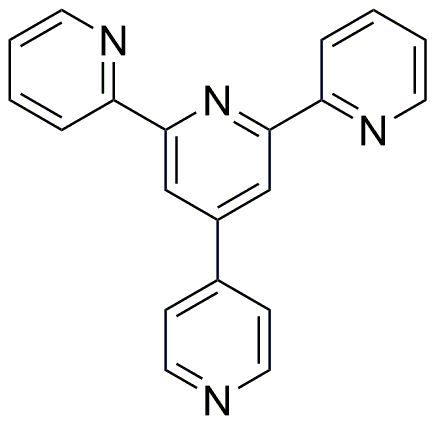4'-(4-Pyridyl)-2,2':6',2''-terpyridine is widely utilized in research focused on:
- Coordination Chemistry: This compound serves as a versatile ligand in coordination complexes, enhancing the stability and reactivity of metal ions, which is crucial in catalysis and materials science.
- Organic Electronics: Its unique electronic properties make it valuable in the development of organic light-emitting diodes (OLEDs) and organic photovoltaics, contributing to advancements in energy-efficient technologies.
- Sensor Technology: The compound is employed in the fabrication of sensors for detecting metal ions and other analytes, offering high sensitivity and selectivity, which is essential for environmental monitoring.
- Pharmaceutical Applications: It is explored for its potential in drug development, particularly in creating compounds that can target specific biological pathways, aiding in the treatment of various diseases.
- Supramolecular Chemistry: This chemical plays a significant role in the formation of supramolecular assemblies, which are important for developing new materials with tailored properties for applications in nanotechnology.
General Information
Properties
Safety and Regulations
Applications
4'-(4-Pyridyl)-2,2':6',2''-terpyridine is widely utilized in research focused on:
- Coordination Chemistry: This compound serves as a versatile ligand in coordination complexes, enhancing the stability and reactivity of metal ions, which is crucial in catalysis and materials science.
- Organic Electronics: Its unique electronic properties make it valuable in the development of organic light-emitting diodes (OLEDs) and organic photovoltaics, contributing to advancements in energy-efficient technologies.
- Sensor Technology: The compound is employed in the fabrication of sensors for detecting metal ions and other analytes, offering high sensitivity and selectivity, which is essential for environmental monitoring.
- Pharmaceutical Applications: It is explored for its potential in drug development, particularly in creating compounds that can target specific biological pathways, aiding in the treatment of various diseases.
- Supramolecular Chemistry: This chemical plays a significant role in the formation of supramolecular assemblies, which are important for developing new materials with tailored properties for applications in nanotechnology.
Documents
Safety Data Sheets (SDS)
The SDS provides comprehensive safety information on handling, storage, and disposal of the product.
Product Specification (PS)
The PS provides a comprehensive breakdown of the product’s properties, including chemical composition, physical state, purity, and storage requirements. It also details acceptable quality ranges and the product's intended applications.
Certificates of Analysis (COA)
Search for Certificates of Analysis (COA) by entering the products Lot Number. Lot and Batch Numbers can be found on a product’s label following the words ‘Lot’ or ‘Batch’.
Numéro de catalogue
Numéro de lot/série
Certificates Of Origin (COO)
This COO confirms the country where the product was manufactured, and also details the materials and components used in it and whether it is derived from natural, synthetic, or other specific sources. This certificate may be required for customs, trade, and regulatory compliance.
Numéro de catalogue
Numéro de lot/série
Safety Data Sheets (SDS)
The SDS provides comprehensive safety information on handling, storage, and disposal of the product.
DownloadProduct Specification (PS)
The PS provides a comprehensive breakdown of the product’s properties, including chemical composition, physical state, purity, and storage requirements. It also details acceptable quality ranges and the product's intended applications.
DownloadCertificates of Analysis (COA)
Search for Certificates of Analysis (COA) by entering the products Lot Number. Lot and Batch Numbers can be found on a product’s label following the words ‘Lot’ or ‘Batch’.
Numéro de catalogue
Numéro de lot/série
Certificates Of Origin (COO)
This COO confirms the country where the product was manufactured, and also details the materials and components used in it and whether it is derived from natural, synthetic, or other specific sources. This certificate may be required for customs, trade, and regulatory compliance.


